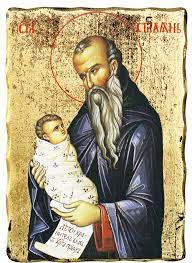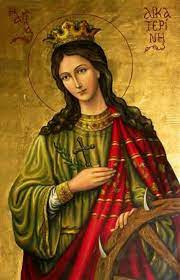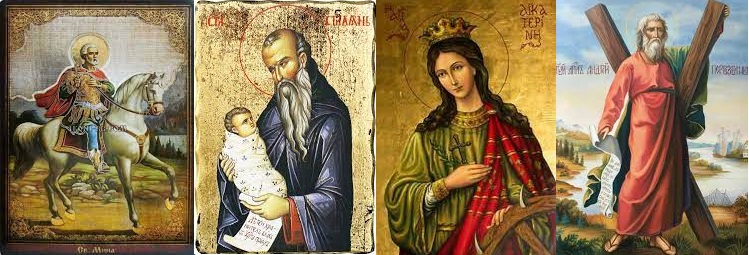From "Once upon a time - manners and worldview of the Bulgarians"
ST. MINA – November 11th
On this day, the Orthodox Church honors the memory of Mina, Victor and Vikentii from Mt. as the most popular and revered is Saint Mina. He is a famous miracle worker and is considered the patron saint of the family.
 The holy martyr Mina was an Egyptian (284-305 AD). A Christian and a soldier. During the time he served under Firmilian, the Roman emperors Diocletian and Maximian issued a decree to persecute and torture Christian pilgrims. Disgusted by these outrages, Mina left his military rank, retired to the mountains and deserts, and devoted himself to fasting and prayer. Despite his recluse, he was captured and severely tortured. His body was cut up and thrown into the fire. Legend has it that when the fire went out, the faithful gathered his remaining relics from the ashes, anointed them with incense and buried them in Alexandria with honors. Subsequently, a church was built in this place in the name of the holy martyr, and many miracles took place in it through the prayers to the saint.
The holy martyr Mina was an Egyptian (284-305 AD). A Christian and a soldier. During the time he served under Firmilian, the Roman emperors Diocletian and Maximian issued a decree to persecute and torture Christian pilgrims. Disgusted by these outrages, Mina left his military rank, retired to the mountains and deserts, and devoted himself to fasting and prayer. Despite his recluse, he was captured and severely tortured. His body was cut up and thrown into the fire. Legend has it that when the fire went out, the faithful gathered his remaining relics from the ashes, anointed them with incense and buried them in Alexandria with honors. Subsequently, a church was built in this place in the name of the holy martyr, and many miracles took place in it through the prayers to the saint.
Name day is celebrated by Mincho, Mina, Minka, Victor, Victoria, Vikentii.
ST. STYLIAN – November 16
 This is the day of the patron and protector of infants, babies and young children. St. Stylian is the patron of pediatrics and pedagogy. He was born in Paphlagonia (Asia Minor). He lived at the end of the 4th and the beginning of the 5th century, Stylian was a miraculous healer of children, which is why he got the nickname "Guardian of Children". In his left hand he held the child, and with his right he made a special, reassuring gesture. In the icons, the child is depicted in diapers, without a halo, and the saint holds a crutch. In an icon from the church in the village of Satovcha, Razlozhko, St. Stiliyan has embraced even 14 diapers.
This is the day of the patron and protector of infants, babies and young children. St. Stylian is the patron of pediatrics and pedagogy. He was born in Paphlagonia (Asia Minor). He lived at the end of the 4th and the beginning of the 5th century, Stylian was a miraculous healer of children, which is why he got the nickname "Guardian of Children". In his left hand he held the child, and with his right he made a special, reassuring gesture. In the icons, the child is depicted in diapers, without a halo, and the saint holds a crutch. In an icon from the church in the village of Satovcha, Razlozhko, St. Stiliyan has embraced even 14 diapers.
Like on a holiday, nothing is done at home all day, so that the children do not get sick. The women knead and distribute loaves and boiled corn for the health of the children.
ST. EKATERINA – November 25
Saint Catherine lived during the reign of Emperor Maximilian (IV century) in the city of Alexandria. She is the patron saint of mothers. Ekaterina's mother was a Christian, but hid her faith. Ekaterina was a rare wise girl, gifted with unearthly beauty. At the age of 18, she already knew the works of philosophers and poets, and studied medical science. She was one of the most educated women of her time. She declared that she would marry the one who surpassed her in intelligence and wealth, but no boy met her approval. Catherine converted to Christianity and tried to convince the emperor that it was a sin to persecute Christians.
She accepted Christianity and was martyred in the name of the faith. Maximilian tried to turn her back to paganism, but she managed to get all his messengers - his own wife and many wise men - to accept the Christian faith. The emperor was angry and ordered her to be imprisoned. But she continued to spread her faith. She was sentenced to death by crucifixion on a wheel, but on the day of the execution the wheel broke and the executioners beheaded her.
According to legends, angels took the body to Mount Sinai, where Moses received enlightenment from God. There, in the 6th century, the Roman Emperor Justinian I founded a monastery that has survived through the centuries to this day. The monastery is Orthodox and preserves valuable, ancient manuscripts from early Christianity. The monastery today bears her name.
In our country, part of the holiday is celebrated more as pagan - against smallpox and rabies. The women prepare fresh loaves, spread them with honey and distribute them to the people close to them - to protect against smallpox, for health, well-being and for St. Katerina. Somewhere they also feed the dogs with this pita, so that they don't get rabies. Since St. Catherine is the patroness of fertility, motherhood, children and the health of people, the Sacrifice of wheat that tames smallpox and rabies is also intended for the saint. The holiday is celebrated especially in southern Bulgaria. In the Strandzhan region, Eastern Thrace and among the settlers from the White Sea on the day of St. Katerina is celebrated against mice (the so-called Mouse holidays). There, the women also do not work, do not touch sharp and cutting objects, smear the hearth with mud and distribute boiled grains (beans, corn, etc.) with their eyes closed to "smear and close the eyes" of the mice.
Folklore collection "Once upon a time - manners and worldview of the Bulgarians"
ANDREW'S DAY - BEAR'S DAY - November 30
This day the church dedicates us to St. Apostle Andrew, and the people call him "Edrei", "Edrinden" or "Mechkin den".
 St. Apostle Andrew the First-Called was a simple fisherman. He lived with his brother Peter on the Lake of Tiberias. They are one of the first followers of John the Forerunner. Apostle Andrew preached Christianity until the end of his life. Spreads the word of God among the Balkan Black Sea peoples and the Scythians. St. Andrew is crucified and dies in agony. He was crucified in the city of Patras, Greece, in the shape of the letter "X".
St. Apostle Andrew the First-Called was a simple fisherman. He lived with his brother Peter on the Lake of Tiberias. They are one of the first followers of John the Forerunner. Apostle Andrew preached Christianity until the end of his life. Spreads the word of God among the Balkan Black Sea peoples and the Scythians. St. Andrew is crucified and dies in agony. He was crucified in the city of Patras, Greece, in the shape of the letter "X".
It has been known since time immemorial that the Bulgarians had deep knowledge of astronomy, the Bulgarian calendar is the oldest and most accurate so far. According to them, the increase of the day begins astronomically from this day. An old proverb says: "On Edrei, the day begins to grow as big as a millet (wheat, poppy or mustard) grain". The day is associated with many rites and customs aimed at abundance and fertility in the coming year. The main dish is stew, which the owner of the house prepared in the early morning or the evening before the holiday - oats, beans, corn, wheat, lentils, barley, etc. Just as pulses enlarge, thicken after heat treatment, so the crops were intended to thicken. It was obligatory for the whole family and the animals to eat from the prepared meal. What was left was distributed around the neighborhood.
The other symbol of this day is the bear, especially in Northern Bulgaria. The tradition says that St. Andrei was a hermit and lived in the mountains. He had a field from which he fed, but once a bear ate his ox. The saint got angry and caught the bear. But he did not kill her, but yoked her to the place of the ox and tilled his fields. He subjugated her to his will, and since then he has cultivated his land with her and has always ridden it. That is why people consider St. Andrew as patron and patron of bears. To make the bears mischief, the oldest woman in the family would take a handful of cooked grains and a slice of bread and throw them up the chimney or onto the roof of the house with the incantation: "To you, mezzo, corn, so that you do not eat the raw and do not eat the goods and the people!
© 2023 Iliana Dechkova

